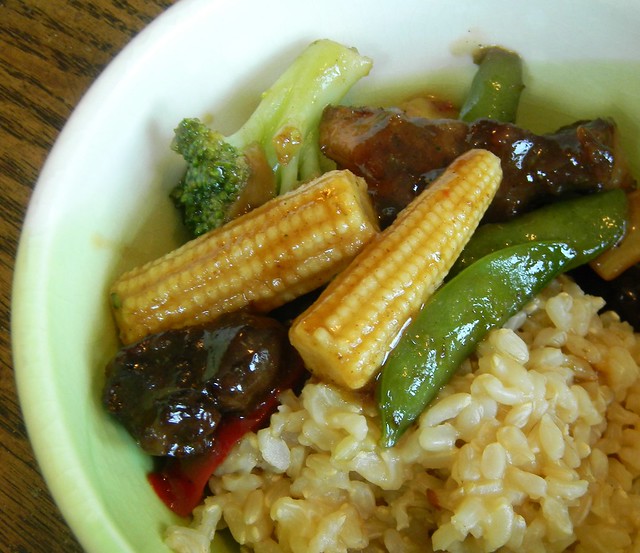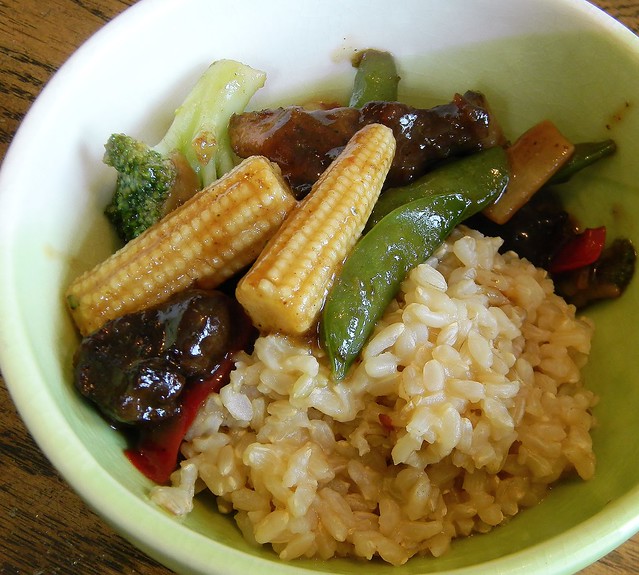Obviously, you need some sort of starch to sop up all the juices and sauce from your concoction, and for that I almost exclusively pick a brown Basmati. Not only does it taste out of this world delicious on its own, but the grains stay more or less distinct, fluffy and fragrant (the word 'Basmati' actually means 'queen of fragrance' in Sanskrit). It's also one of the healthiest rices, with the most amino acids and essential nutrients as well as a fairly low Glycemic Index (45). Can you tell I freaking adore this stuff??
For me, veggies are the be-all and end-all of a good stir-fry, so I always try (try, mind you) to keep a bunch of stuff in the fridge. That said, when I'm cooking for one it doesn't always make sense to buy full packages of snow peas, bamboo shoots and the like, so I scope around until I find a frozen mix that looks good. No big deal.
Then the crowning glory - the sauce. I've written before about my love of San-J's cooking sauces and tamari, not only because they're gluten free but they are consistently delicious! The company was gracious enough to reach out to me at Christmastime with a box of their product, and recently contacted me again to ask if I'd be interested in trying one of their new cooking sauces - Mongolian Sauce. We love Mongolian BBQ here and couldn't wait to give it a taste!
It was a twist of fate that the day the sauce arrived at my door was also a "grill night" at our house. I had originally planned to make a stir-fry with fresh ingredients and raw meat, but the leftover steak presented itself and made me wonder if marinating it overnight would help re-tenderize it, as well as infusing it with the sweet and spicy elements of the sauce. I whisked up a fairly simple blend of both the Mongolian and Szechuan Sauces, some red wine, beef broth, sesame oil and chili flakes, then sliced the cooled steak and popped it in. The next night, I stir-fried the beef with my go-to frozen veggies and poured the marinade overtop to form a sweet and spicy sauce that soaked into the rice, making the whole bowl one of deliciousness. I can't wait to try the sauce on tofu, or even grilled mushroom caps!
San-J is online - visit their website, facebook or twitter page for more info. Canadians can get some awesome coupons for the company's Tamari and Cooking Sauces on The Healthy Shopper site too.
Shared with Gluten Free Friday - turns out Cindy likes San-J too!
Mongolian Beef Stir Fry
Serves 2
3 tbsp San-J Mongolian Sauce, divided
1 tbsp San-J Szechuan Sauce
½ tsp sesame oil
2 tbsp red wine
¼ cup gluten free, low-sodium beef broth
Pinch chili flakes
1 clove garlic, minced
4 oz cooked steak (I used leftover grilled sirloin), sliced into strips or cubed
1 tbsp sweet rice flour (or cornstarch), divided
2 tsp coconut oil
 1 lb frozen stir-fry vegetables
1 lb frozen stir-fry vegetables1 cup cooked brown Basmati rice, for serving
- In a bowl, whisk together 1 tbsp Mongolian Sauce, Szechuan Sauce, sesame oil, wine, broth, chili flakes and garlic.
- Add the cooked beef, cover and marinate for 24 hours.
- Drain beef, reserving marinade, and pat with paper towel to dry slightly. Toss with half the sweet rice flour.
- Whisk remaining flour into the marinade, along with remaining Mongolian Sauce.
- Melt oil in a wok or deep saute pan over high heat.
- Add the dredged meat and cook, stirring constantly, 1 minute.
- Add vegetables and cook 7-8 minutes, until tender.
- Whisk the sauce mixture again and pour into the wok.
- Cook, stirring often, until sauce thickens and coats the vegetables and meat.
- Serve immediately over rice.
Calories: 453.4
Total Fat: 13.7 g
Cholesterol: 20.0 mg
Sodium: 963.8 mg
Total Carbs: 57.9 g
Dietary Fiber: 5.5 g
Protein: 25.7 g
*Disclaimer - I was given the Mongolian Sauce for the purposes of this review. All opinions are my own


No comments :
Post a Comment
Thanks for the feedback!